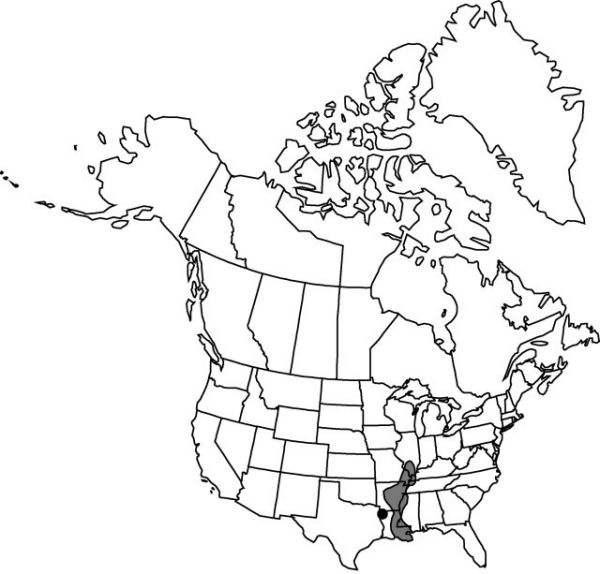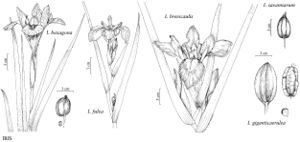Iris fulva
Bot. Mag. 36: plate 1496. 1812.
Rhizomes compact, greenish brown or sometimes red-tinged, many-branched, with ringlike scars of old leaves, 1.5–2 cm diam. Stems simple or sometimes 1–2-branched, solid, 3–9 dm. Leaves: basal arching distally, blade bright green, lightly ribbed, linear-ensiform, 6–10 dm × 1.5–2.5 cm; cauline subtending branches, blade 4.5–6 dm. Inflorescence units 1–2-flowered; spathes unequal, outer green, 10–12 cm, herbaceous, inner 6–8 cm, partly scarious. Flowers: perianth copper colored or reddish-brown (yellow in forma fulvaurea); floral-tube hollow to ovary, 2–2.5 cm; sepals widely spreading or arching downward, obovate, with 1–3 prominent veins, 4.5–5.5 cm, glabrous, often with lighter yellow basal signal; petals spreading or declining with sepals, 4–5 × 1.5–2 cm, base gradually attenuate, apex deeply emarginate; ovary green, hexagonal, 1.5–1.7 cm; style convex, not keeled, 1.8–2 cm, crests reflexed, rounded-triangular, margins shallowly toothed; stigmas 2-lobed, lobes pointed, margins entire; pedicel 2–4 cm. Capsules remaining green even after seeds mature, oblongelliptic, hexagonal in cross-section, with 6 equally spaced ribs, short beak, 4.5–8 × 2.5 cm. Seeds in 2 rows per locule, irregular, flattened, 10–15 mm, corky. 2n = 42.
Phenology: Flowering Apr–Jun.
Habitat: Shallow water or low wet areas
Distribution

Ark., Ill., Ky., La., Miss., Mo., Tenn.
Discussion
Iris fulva hybridizes with I. brevicaulis to produce I. ×fulvala Dykes, which has reddish purple sepals; with I. giganticaerulea to produce I. ×vinicolor Small; and with I. savannarum to produce I. ×cacique (J. Berry) N. C. Henderson.
Selected References
None.
Lower Taxa
"dm" is not declared as a valid unit of measurement for this property."dm" is not declared as a valid unit of measurement for this property. "dm" is not declared as a valid unit of measurement for this property."decreasing" is not a number."dm" is not declared as a valid unit of measurement for this property.
